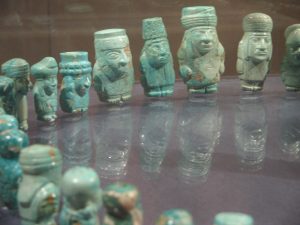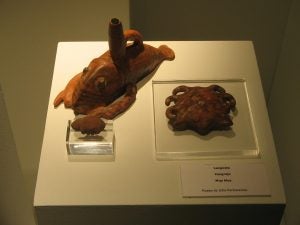
I have undertaken a series of independent research projects exploring and comparing science, art, and archaeology museums. In line with my interest in knowledge communities, these projects explore museums as sites where knowledge is disseminated. Following Conn (1998), I’m interested in the parallel history of museums and universities, as places where the humanistic, social, and natural sciences create and share knowledge, and the role of material objects in this knowledge-making.
Revitalizing the Archive of V.G. Childe
With Prof. Marie-Louise Stig-Sorenson, I used the archives of the Cambridge Museum of Archaeology and Anthropology to explore the after-life of the artifacts collected by V.G. Childe at the site of Toszeg, Hungrey: his first excavation, and the site he used to develop his typology of European Prehistory, that is still in use today. Marie-Louise and I posed the question of how and whether old archaeological collections, that were once highly significant but now languish in museum basements, can be revitalized and re-inserted into contemporary archaeological conversations.
The article we published on this work is available here: (PDF)
The Inca as Objects v. Narratives
Continuing this theme, I later examined exhibits in seven archaeology museums in Peru, Spain, and the US: The Peabody at Yale, The Museo de América in Madrid, The Museo Nacional de Arqueología, Antropología e Historia del Perú in Lima, and in Cusco The Museo de Arte Precolombian, The Museo Inca, the Museo del Sitio del Qoricancha and the Museo Histórico Regional — to contrast the way archaeological objects are presented as ‘knowable’ by non-expert audiences.

Using exhibits on the Inca as a comparison point, I compared a spectrum of constructivist and positivist approaches to classifying and presenting material objects, and considered how these approaches reflected the museums’ contrasting expectations of the anticipated museum visitor (e.g., the visitor who is an indigenous citizen, versus a foreign tourist, versus a school or university student).
I argued that there is indeed a disconnect between the epistemological assumptions underlying contemporary archaeological research in universities and how the museums invited visitors to know the past; but if we take into consideration the culturally diverse audiences many of these museums reached, this disconnect did not necessarily lead to a poorer visitor experience.
Science and Technology Museums

This research was heavily influenced by my involvement in an internship program called “MSI SciTech Chicago Outreach Pilot Exploration” (MSCOPE) organized by the Museum of Science and Industry in Chicago, SciTech in Aurora, and the University of Chicago physics department, that taught graduate students from both the natural and social sciences how to design science museum exhibits for adult and child audiences.
This internship introduced me to the literature on the Public Understanding of Science (PUS), and research undertaken by science museums that emphasis interactive learning (for instance, the Exploratorium in San Francisco and Technopolis in Belgium). I have explicitly sought to combine this PUS literature with an anthropological approach to museum studies, when studying archaeology museums.
Campus Art Museums
In 2013-14 I was commissioned to carry out an ethnographic study a campus museum, the Smart Museum of Art at the University of Chicago, that again explored the museum’s contrasting missions to educate and serve multiple audiences (in this case, undergraduates, in addition to the mostly low-income community surrounding the university campus).
Exploring how undergraduates students interact with a campus museum as students and employees, this project sought to understand what students gain from their experience in terms of career skills, understandings of museumography, and ways of seeing/experiencing art objects; additionally, how the museum as an institution is shaped in return by active and engaged undergraduate participation.
The final report produced for the museum focused on the intersection of education and labor, and documented the significant impact of providing both wages and training to low and mid-income students who would not otherwise be able to afford to undertake unpaid internships. That report is available here: (PDF).


